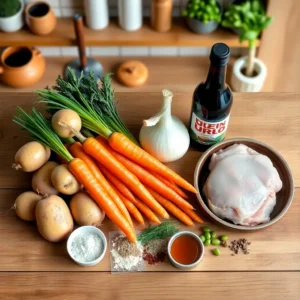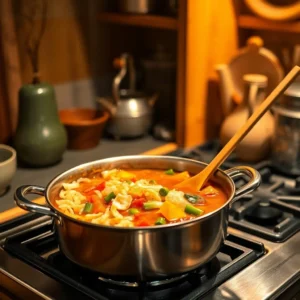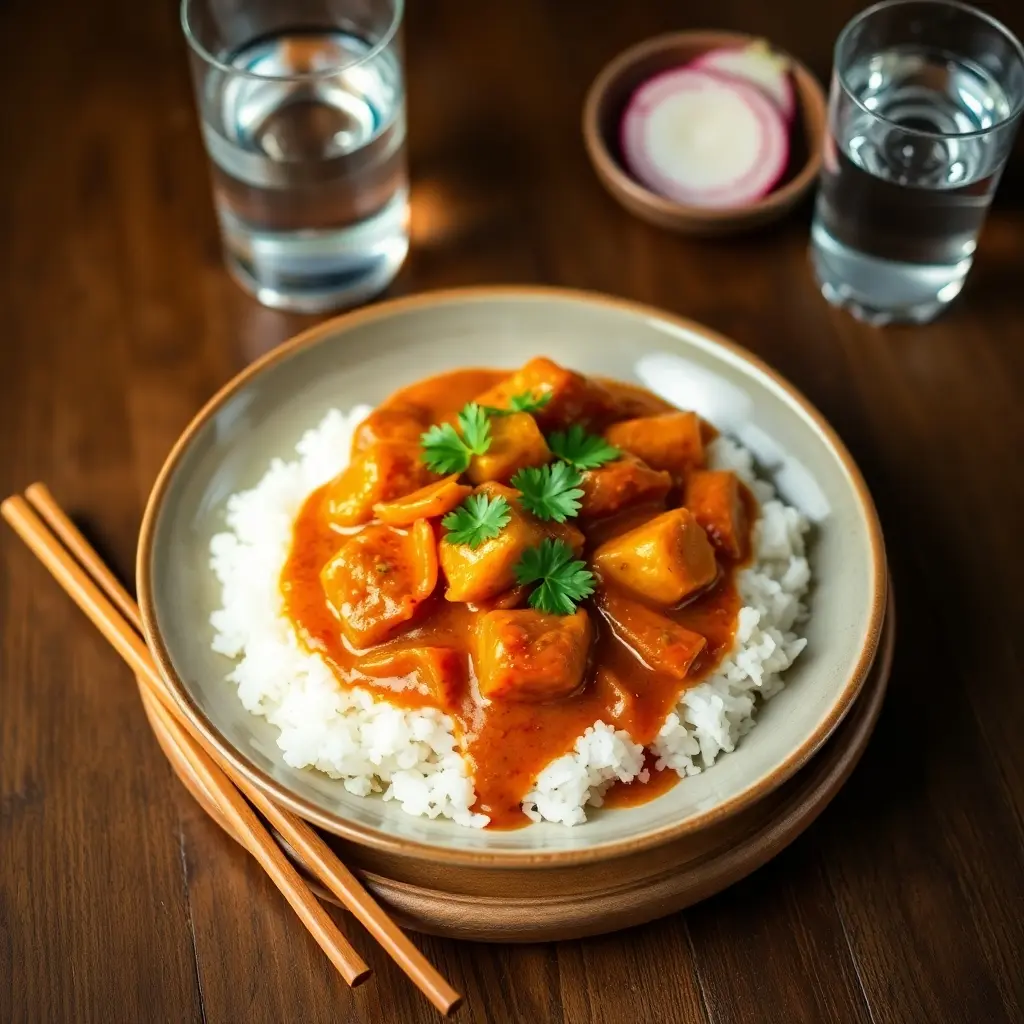Japanese curry, or kare, is a beloved dish that has captured the hearts and taste buds of people worldwide. With its rich, mildly spiced flavor and comforting aroma, this dish has a unique identity that sets it apart from other curries. In this guide, we’ll explore everything you need to know to make an authentic Japanese curry recipe at home. From its intriguing history to step-by-step cooking instructions and creative variations, you’re in for a treat! Let’s dive into this culinary journey and bring a piece of Japan to your kitchen.
Introduction to Japanese Curry Recipe
What is Japanese Curry?
Japanese curry is a hearty and flavorful dish that combines meat, vegetables, and a thick, savory curry sauce, typically served over steamed rice. Unlike its spicier Indian counterpart, Japanese curry is mild, sweet, and slightly thickened, making it a favorite comfort food for many.
History of Japanese Curry
The origins of Japanese curry trace back to the late 19th century when it was introduced by the British. Adapted to suit local palates, it quickly evolved into a staple dish in Japanese households. Unlike Indian curry, which features a blend of aromatic spices, Japanese curry focuses on a sweeter, umami-rich flavor profile.
Popularity of Japanese Curry in Japan and Abroad
Today, you’ll find this dish served in various forms—home-cooked meals, school lunches, and even specialty restaurants. Its versatility and adaptability make it a popular choice not only in Japan but around the globe.
Why You Should Try Making Japanese Curry at Home
Cooking Japanese curry at home offers a rewarding experience, allowing you to tailor the recipe to your preferences. Whether you want a vegetarian version, a spicier kick, or a creamier sauce, the options are endless. Plus, homemade curry is fresher and more satisfying than store-bought alternatives.
Overview of the Recipe
In this recipe, we’ll cover:
- Selecting essential ingredients like curry roux, vegetables, and protein.
- Step-by-step instructions to prepare a rich and delicious curry.
- Tips, variations, and toppings to elevate the dish.
Essential Ingredients for Japanese Curry
 Key Ingredients for Authentic Japanese Curry Recipe
Key Ingredients for Authentic Japanese Curry Recipe
Creating an authentic Japanese curry recipe begins with understanding its essential ingredients. Each element plays a critical role in achieving the dish’s unique flavor and texture. Whether you’re preparing it from scratch or using a store-bought roux, the following components are indispensable.
Curry Roux
At the heart of any Japanese curry lies the curry roux. This thickening agent, made from a blend of flour, butter, and spices, is what gives the curry its luscious, velvety texture. You can make roux at home for maximum control over the flavor, or opt for ready-made blocks, which are widely available.
Proteins
Protein selection is flexible, which makes Japanese curry incredibly versatile. Chicken, with its tender, juicy texture, is the most popular choice. However, beef offers a richer taste, while tofu works wonderfully for vegetarians. Regardless of your choice, marinate the protein with a pinch of salt and pepper to enhance its natural flavor before cooking.
Vegetables
Vegetables are the backbone of this dish, lending it sweetness and heartiness. Staples like potatoes, carrots, and onions are must-haves. For added flair, mushrooms, peas, or even chunks of sweet potatoes can be included. The key is to chop the vegetables into uniform pieces so they cook evenly.
Seasonings and Stock
What truly elevates a Japanese curry recipe is the combination of seasonings and stock. A blend of soy sauce, Worcestershire sauce, and dashi stock creates an umami-rich base that complements the curry roux perfectly. If dashi isn’t available, chicken stock or vegetable broth can work as substitutes.
A Quick Note on Substitutions
If you’re aiming for a gluten-free or vegan version, substitutes like gluten-free flour for the roux or vegetable stock for dashi can easily adapt the dish to your dietary needs.
By gathering these ingredients and preparing them thoughtfully, you’re setting the stage for a dish that’s as delightful as it is comforting.
Step-by-Step Cooking Instructions
 How to Make Japanese Curry at Home
How to Make Japanese Curry at Home
Now that you’ve gathered all the necessary ingredients, it’s time to dive into the cooking process. Follow these simple steps, and you’ll have a delicious Japanese curry recipe ready to impress your family or guests.
Preparing the Ingredients
Before you even start cooking, it’s crucial to prepare your ingredients properly. First, peel and chop the vegetables into bite-sized pieces, ensuring that each piece is uniform so they cook evenly. Meanwhile, cut your protein—whether it’s chicken, beef, or tofu—into cubes or slices, depending on your preference.
For extra flavor, consider marinating your protein with a touch of soy sauce and a sprinkle of salt. This step may not seem significant, but it enhances the overall taste remarkably.
Cooking the Curry Base
Begin by heating a large pot over medium heat and adding a small amount of oil. Toss in the onions and sauté them until they become soft and slightly golden. This process not only builds sweetness but also forms the foundation for the curry’s rich flavor.
Next, add your protein to the pot. Stir occasionally, allowing the meat to sear lightly on all sides. For vegetarians, sauté tofu or mushrooms instead. Afterward, throw in the carrots and potatoes, stirring gently to coat them with the flavors in the pot.
Simmering and Blending Flavors
Pour the stock or water into the pot, ensuring that it fully covers the ingredients. Bring everything to a boil, but don’t stop there. Lower the heat to a gentle simmer, letting the mixture cook for about 20 minutes. This step is vital because it allows the flavors to meld beautifully.
Once the vegetables are tender, break the curry roux into smaller pieces and stir it into the pot. Watch as the sauce thickens and transforms into that iconic Japanese curry consistency.
Final Adjustments
Finally, taste your curry and adjust the seasoning as needed. A splash of soy sauce or a pinch of sugar can help balance the flavors if they feel too sharp or flat. If the sauce seems too thick, add a bit more stock until it reaches your desired consistency.
Variations and Toppings
Creative Japanese Curry Variations
The beauty of Japanese curry lies in its flexibility. Whether you prefer to keep it classic or experiment with bold twists, there are countless ways to customize this dish to suit your palate. Let’s explore some popular variations and exciting topping ideas that elevate the humble curry into a gourmet delight.
Different Protein Choices
While chicken remains the most common protein in Japanese curry recipes, there’s no reason to limit yourself. Beef adds a deeper, heartier flavor, especially when slow-cooked to tender perfection. If you’re a seafood lover, prawns or white fish create a lighter, more delicate curry. For vegetarians, tofu, chickpeas, or even lentils work as satisfying alternatives that absorb the rich curry flavors beautifully.
Fusion Options
If you’re feeling adventurous, try incorporating elements from other cuisines. Adding coconut milk creates a creamier, subtly sweet curry reminiscent of Thai flavors. Cheese, when melted into the curry, offers a luscious texture and a surprising burst of indulgence. Additionally, spices like cinnamon or nutmeg can lend a festive twist to the dish.
Popular Toppings and Accompaniments
The toppings can truly transform your Japanese curry into something extraordinary. A crispy breaded chicken cutlet, also known as katsu, is one of the most iconic pairings. Hard-boiled eggs sliced in half add a satisfying protein boost. For a tangy contrast, serve with pickled radish or ginger on the side.
Other delightful accompaniments include fried onions, roasted nuts, or even a drizzle of yogurt for extra creaminess. The goal here is to add layers of flavor and texture to complement the dish.
Serving Ideas
Japanese curry is traditionally served over a steaming bed of white rice, but why stop there? You can ladle it over udon noodles for a hearty meal or use it as a filling for kare pan—a deep-fried curry bread that’s immensely popular in Japan.
This versatility ensures there’s always a fresh way to enjoy your Japanese curry recipe. Whether you stick to the classics or venture into uncharted culinary territory, each bite is bound to be a memorable one.
Tips for Perfect Japanese Curry Every Time
Expert Tips for Cooking Japanese Curry
Making Japanese curry isn’t difficult, but a few tips can help you elevate it from good to exceptional. Whether you’re a first-timer or a seasoned cook, these techniques will ensure your curry is flavorful, balanced, and unforgettable.
Balancing Flavors
The hallmark of a great Japanese curry recipe lies in its ability to balance sweetness, spiciness, and umami. To achieve this harmony, consider adding a touch of grated apple or honey for natural sweetness. If you want more depth, a splash of soy sauce or Worcestershire sauce can work wonders. When it comes to heat, choose a curry roux with a spice level that suits your taste, or add a pinch of cayenne pepper for an extra kick.
Cooking Techniques for Best Results
Low and slow cooking is key to developing the dish’s complex flavors. Sautéing the onions until golden brown enhances their natural sweetness, while simmering the curry gently ensures that the ingredients meld beautifully. To avoid lumps when adding the curry roux, break it into smaller pieces and stir constantly as it dissolves.
Don’t rush the process, as the longer the curry simmers, the richer and more flavorful it becomes. On busy days, consider using a slow cooker to achieve the same results with minimal effort.
Adjustments for Special Diets
Adapting Japanese curry to fit various dietary needs is easier than you might think. For a gluten-free version, use cornstarch instead of flour in the roux or opt for a gluten-free curry block. To make it vegan, substitute dashi with vegetable stock and use tofu or chickpeas as the protein.
If you’re watching your calorie intake, reduce the amount of oil used in sautéing and focus on lean proteins like chicken breast or plant-based alternatives.
Additional Tricks for Success
- To thicken the curry further, mash a few pieces of cooked potato directly into the sauce.
- If your curry tastes too sharp or bitter, a splash of milk or cream can mellow the flavors instantly.
- Let the curry sit for a few hours—or even overnight—in the refrigerator. Reheating it the next day often enhances the taste!
Nutritional Information and Considerations
Nutritional Facts About Japanese Curry
While Japanese curry is undeniably delicious, it’s important to consider its nutritional profile. By understanding what goes into this dish, you can make informed choices and even tweak the recipe to suit your dietary needs.
Caloric Breakdown
A typical serving of Japanese curry with rice contains around 400 to 600 calories, depending on the ingredients used. Proteins like chicken or tofu tend to keep the calorie count moderate, while beef or additional toppings such as cheese may increase it. Adjusting portion sizes or choosing lower-calorie ingredients can help if you’re aiming to reduce overall calorie intake.
Macronutrient Content
The dish is primarily carbohydrate-heavy due to the rice and potatoes, making it a great source of energy. On average, a serving provides:
- Carbohydrates: Around 60–70 grams.
- Protein: 15–25 grams, depending on your chosen protein.
- Fat: 10–20 grams, influenced by the type and amount of roux or oil used.
By tweaking these proportions—such as using less rice or replacing potatoes with low-carb vegetables like zucchini—you can tailor the dish to your health goals.
Health Considerations
One aspect to watch out for is sodium content. Store-bought curry roux tends to be high in sodium, which can contribute to excessive salt intake if not monitored. To counter this, opt for low-sodium stock or create your roux from scratch using healthier alternatives.
Additionally, while the combination of vegetables and protein offers nutritional balance, the dish’s high glycemic load may not suit individuals managing diabetes. In such cases, serving the curry with brown rice or quinoa instead of white rice can help stabilize blood sugar levels.
Special Diet Tips
For those following plant-based diets, a vegan Japanese curry recipe can deliver just as much flavor without any animal products. Replacing curry roux with a combination of flour, plant-based butter, and curry powder is both simple and effective.
Meanwhile, if you’re on a low-carb or keto diet, consider using cauliflower rice and omitting starchy vegetables like potatoes. These substitutions maintain the essence of the dish while aligning with your nutritional preferences.
Understanding the nutritional aspects of Japanese curry empowers you to enjoy this comforting dish while making mindful adjustments to fit your lifestyle. So, whether you indulge occasionally or incorporate it into your weekly meal plan, you can savor every bite guilt-free!
Frequently Asked Questions (FAQs)
Can I Make Japanese Curry Without a Roux?
Yes, you can absolutely make Japanese curry without store-bought roux! To achieve a similar thick and flavorful base, create your own roux using equal parts of flour and butter. Add curry powder, turmeric, and paprika to mimic the traditional flavor. This method is both cost-effective and customizable, allowing you to control the ingredients entirely.
What Are the Best Substitutes for Curry Roux?
If curry roux isn’t available, there are alternatives you can try. A mixture of cornstarch and water can thicken the curry, while soy sauce, miso, and spices can enhance the flavor. Coconut milk can also add a creamy texture, although it will introduce a slightly different taste profile.
How Do I Store Leftover Japanese Curry?
Storing leftover curry is simple! Allow it to cool to room temperature before transferring it into an airtight container. Refrigerate for up to 3 days or freeze for up to a month. When reheating, add a splash of water or stock to maintain the sauce’s consistency, as it tends to thicken when cooled.
Can I Freeze Japanese Curry?
Absolutely! Freezing is an excellent way to preserve Japanese curry for future meals. To do this, portion the curry into freezer-safe containers or bags, leaving a bit of space for expansion. When you’re ready to enjoy it again, thaw overnight in the fridge and reheat gently on the stove.
What’s the Best Way to Thicken Japanese Curry?
If your curry ends up too watery, there are several ways to thicken it. Adding a small amount of mashed potato or a slurry of cornstarch and water can quickly resolve the issue. Another trick is to let the curry simmer uncovered, allowing the excess liquid to evaporate naturally.
How Spicy Is Japanese Curry Compared to Indian Curry?
Japanese curry is typically milder than Indian curry, offering a sweeter and less intense heat profile. However, spice levels can vary based on the roux you choose or the additional spices you add. For those who prefer more heat, incorporating cayenne pepper or chili flakes is an easy solution.

